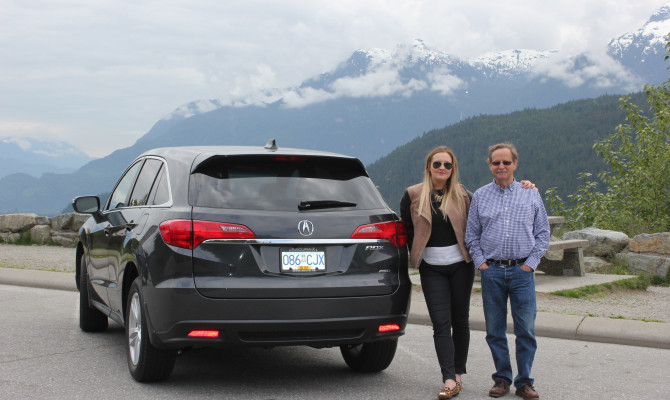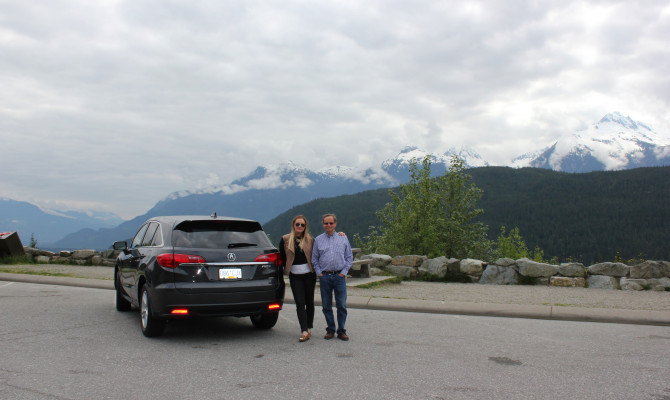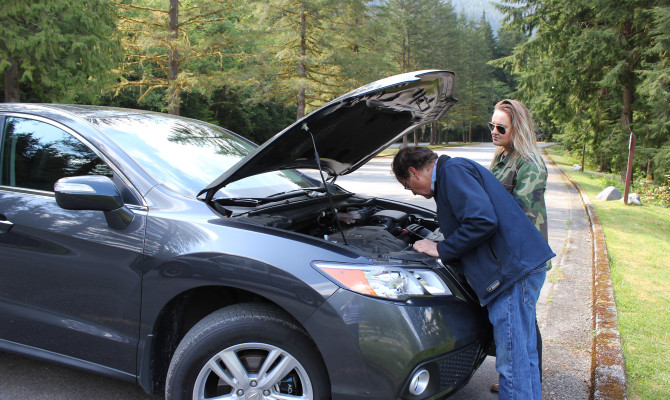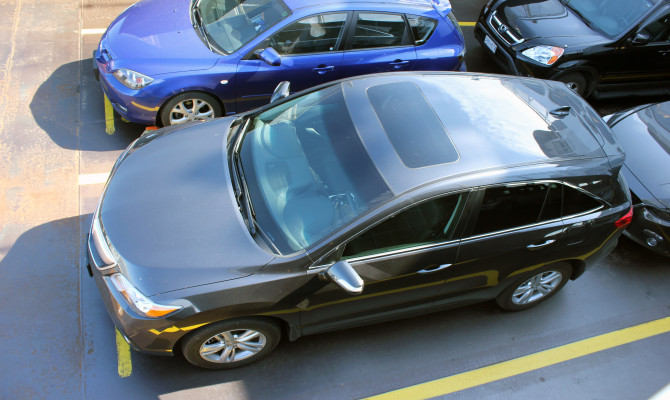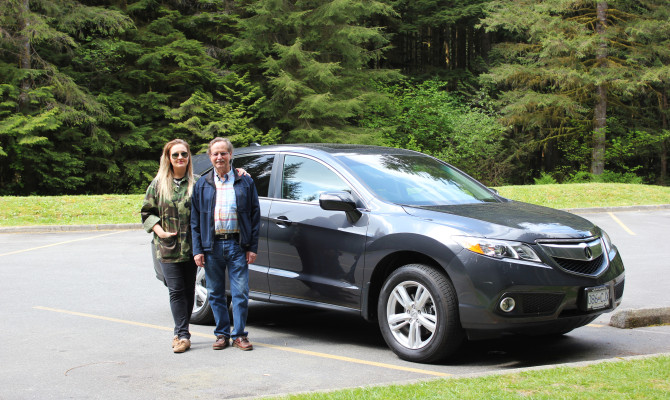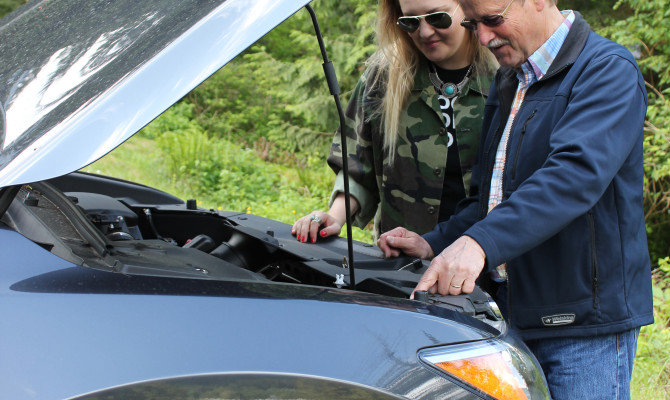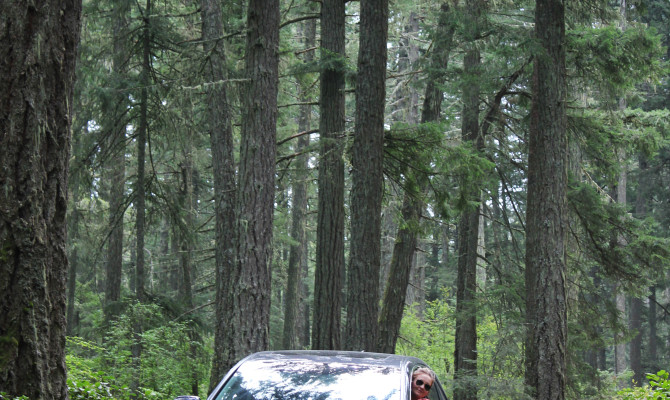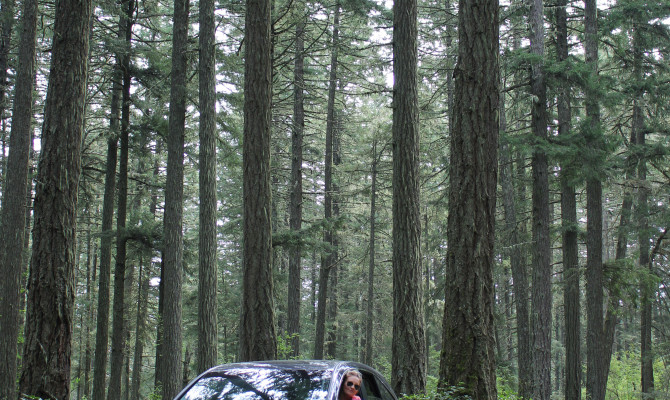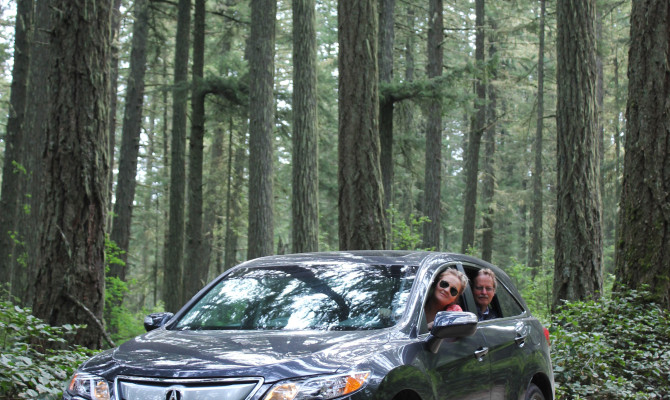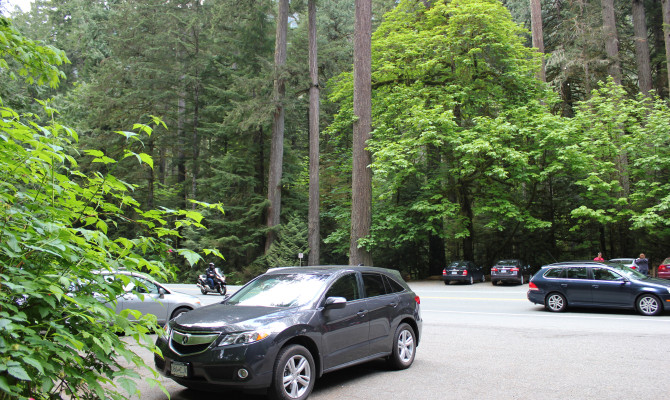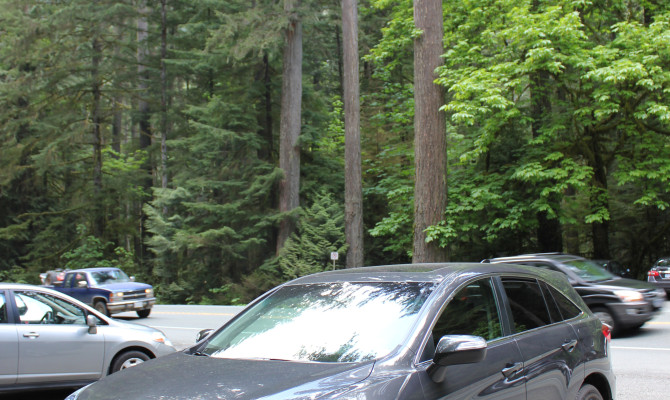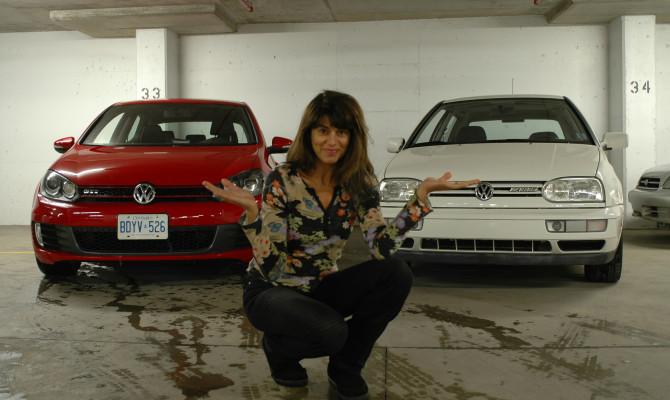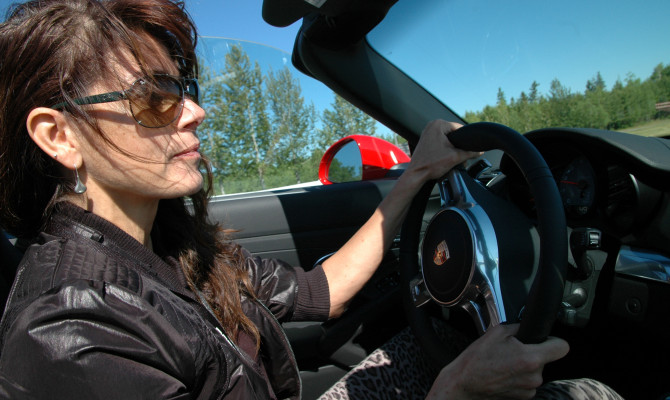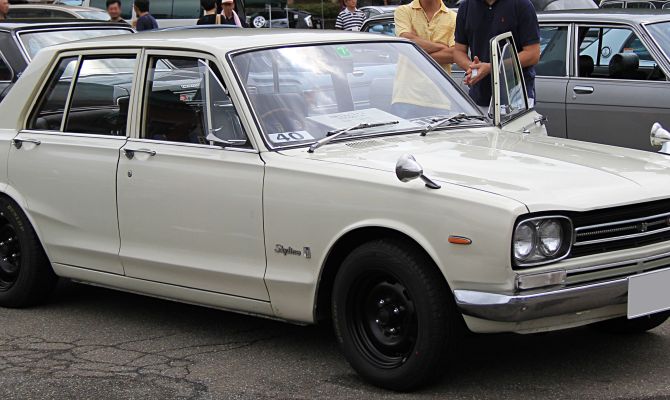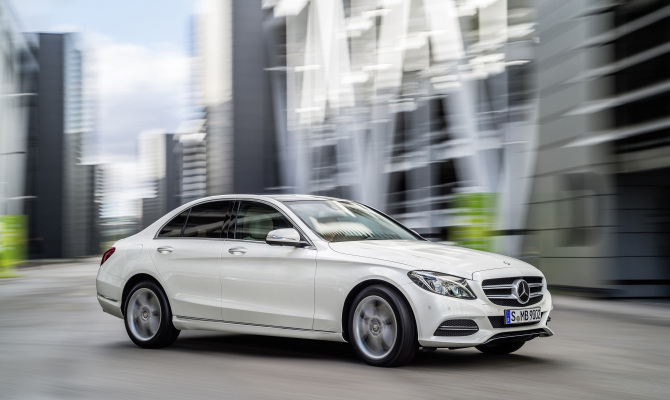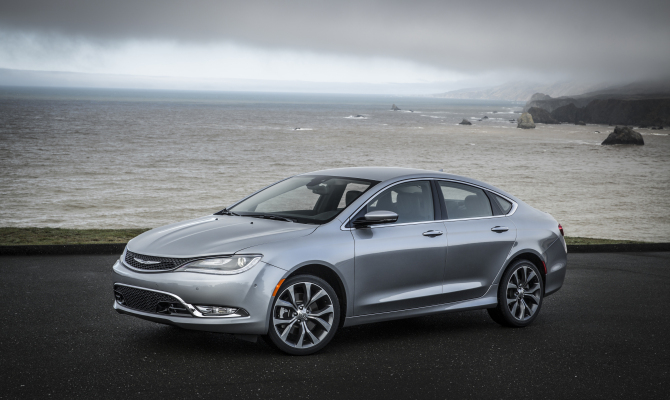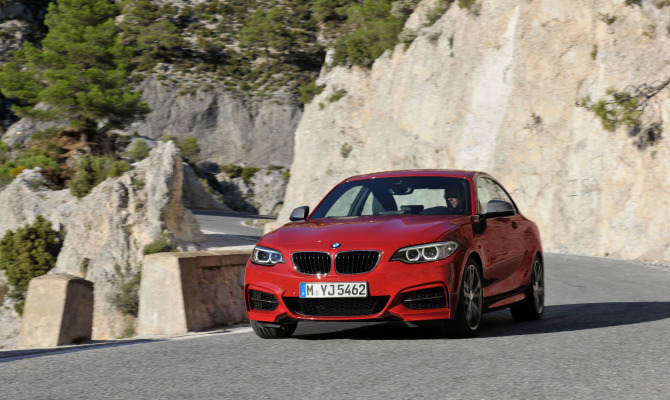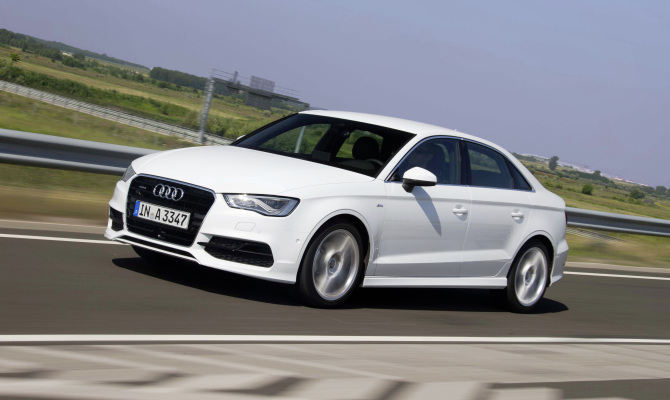by Hayley Thomas
“The pleasure of cruising the coastline was amplified by the views offered from the RDX’s raised stance.”
Exploring beautiful British Columbia for the first time should enjoyed in the comfort and views offered by a high-end sport-utility vehicle.
Having recently moved to the province from Nova Scotia, it was time for my parents to make their first trek to this side of the country, so the pressure was on to find an appropriate vehicle to show off my new ‘home’.
A 2015 Acura RDX was available in the media fleet: Its 273-horsepower, 3.5 litre V-6 engine, along with a 6-speed automatic transmission, persuaded me it would get us where we needed to go.
My parents, Nadine and George Thomas, started their trip in Vancouver, in the heart of the city. On the first evening I offered to take them for a drive around town to show them the hot spots. The RDX offers soft leather seats featuring 8-way power adjustability, coupled with a very sleek and stylish exterior, which incorporates an aerodynamic efficient body. To say we felt cool driving it through the city, with music pumping from the 360-watt audio system, is an understatement.
Within a few days, we were on our way to explore Salt Spring Island. At this point, it was time for my father to get his hands on the wheel to see what the RDX was “really made of.”
Our joint verdict is the RDX offers great handling with an agile yet secure feel – the vehicle integrates Amplitude Reactive Dampers that analyze the driver’s input against the road conditions to adjust the drive to the road you’re travelling.
Like most dads, mine never needs directions. However, when we were on our way to the Saturday Market we “somehow” ended up on a dead-end back road. Luckily, the GPS navigation system gave my mum a much-needed break from map reading. The system has the ability to pinpoint your location almost anywhere in North America, and is equipped with two options of relaying your route: either by voice or a real-time moving map. This feature is a sure-fire way of ensuring you get to where you need to go, while removing any second-guessing from the equation.
We continued our adventures on Vancouver Island from Nanaimo through the Vancouver Island mountain ranges. At this point, I once again took over driving without the hassle of re-setting my seat preferences; the settings were conveniently programmed into the seat position memory. Once back on the road I really put the pedal to the metal – the acceleration was brisk and delivered plenty of power. With that much power, typically comes a hefty bill at the gas station and not because of all the ice cream sandwiches purchased there. However, a comparison check shows the RDX offers fuel efficiency is rivalled by very few luxury SUVs. Given the often-steep gas prices we see these days, the RDX’s fuel economy on average is 10.6 litres/100 km, allowing motorists to enjoy summer drives guilt-free.
The pleasure of cruising the coastline was amplified by the views offered from the RDX’s raised stance. Driving as the sun dipped below the horizon meant it was time to open the moonroof. The moonroof is easily operated with a one-touch power mechanism along with a visor that actively reduces the vibrations and noise associated with having a window open, allowing for a smooth and noise-free ride.
Last, but certainly not least, I had long been awaiting my parents’ arrival with the anticipation of finally properly learning how to parallel park. Much to my surprise, the Acura RDX provides all of the tools required to successfully complete this complex and sometimes dangerous (when I’m behind the wheel) task. The vehicle includes a multi-angle rear-view camera along with reverse tilt dual mirrors that provide curb views. I can now parallel park in the city without chagrin – hold onto your curbside parking spots, fellow motorists.
2015 Acura RDX
Base price: $41,390
Price as tested, Tech edition: $44,390 – plus $1,995 freight & pdi
“It’s unique and it’s India’s closest comparison to the most famous event in the world the Pebble Beach Concours d’Elegance..” (more…)
“Music and road trips go together like American interstate highways and bad coffee.”
by Lisa Calvi
The first time I drove on public roads, I was at the wheel of my then-boyfriend’s Chevy Vega.
I remember cresting a hill and gasping sharply with the realization that I was in control. The curvy road splayed out far below wasn’t some carnival ride with someone else at the helm. I couldn’t just close my eyes and wait for the terror to subside. It was up to me.
I could coast down and weave gently through the corners or I could squeeze the throttle and feel the rush of acceleration and adrenaline. As a sixteen-year-old living in a small town, driving meant autonomy.
There were plenty of road trips growing up. I remember long hauls from Toronto to North Carolina and Florida with my dad driving. After he and my mom left Italy, they seemed to have an urge to see the new continent they now called home. Driving, I think, satisfied their curiosity about the world that they wanted to share with us.
When we moved back to Europe for a three-year period during my early teen years, the family would venture out each Sunday in our Peugeot 504 to discover a new region. Mom would be in the passenger seat with the maps and my baby brother asleep on her lap.
There was always music on those road trips. Music and road trips go together like American interstate highways and bad coffee. Music motivates, keeps you alert and adds to the euphoria of the open road.
Some of my fondest memories are of singing with my sister in the back seat of the Peugeot on the winding roads of Central France. Before iPads, iPhones, in-car entertainment systems and satellite radio, there were Beatles’ songs, ‘Michael, Row Your Boat Ashore’, and trying to remember all the words to ‘Bohemian Rhapsody’.
Road games involved spotting license plates from other countries, identifying makes of vehicles and fighting over whose turn it was to be a leaning post for sleeping baby brother, now in the back seat.
I’ve always been interested in cars, roads and travel. I love the growl of a revving eight-cylinder engine. A transport truck rolling down the highway at night all lit up just like a small city still gets me excited. I just never imagined that those things would be so engrained in my work and in my life. With our automotive event planning business, most days of the year, my husband Garry Sowerby and I are on the road.
It was this love of the road that brought us together. We could both relate to the words of Jack Kerouac in his classic ‘On the Road’:
“… We were leaving confusion and nonsense behind and performing our one noble function of the time, move.”
Our first date was a five-hour return drive to a ‘little spot’ my suitor knew. It must have worked. That was 17 years ago. Being ‘on the road’ is when our best scheming takes place. It’s romantic, soul-cleansing and gives us a sense of the wider world.
What about driving, though, actually gripping the wheel and pushing the throttle? Forget the destination, the freedom of movement, the road trip, the music. What is driving?
It’s that feeling that I got as I whipped a Porsche Boxster S around the tight-tight corners at a racetrack, squeezing through coned gates, powering down straight stretches and hearing the resonant instantly-recognizable growl of a Porsche engine. I had never driven faster, with such abandon yet with such intense concentration.
Or maybe I did. The 200 km/h reading on the digital speedometer of the Cadillac ATS I was driving on the back straightaway of one of the fastest, most challenging tracks in North America, Mosport, still flashes in my dreams.
None of this compares to driving my very own car, a pristine white 1999 Volkswagen Golf GTI VR6. When I bought it, I knew there were two extra cylinders under the hood than the Golf GL version and that it had an additional 57 horsepower. But when I drive it, I don’t think about horsepower, torque, or fuel economy.
Did somebody say ‘road trip’?
Follow Lisa on Twitter: @FrontLady
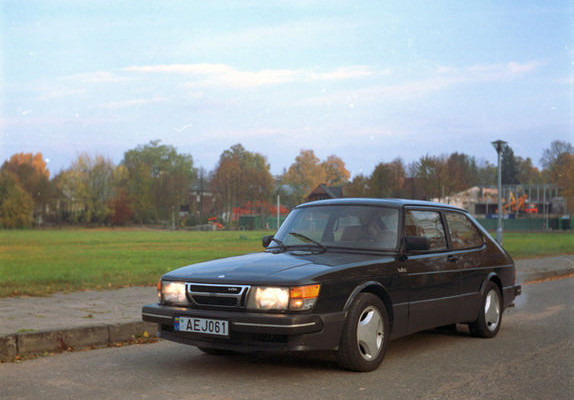
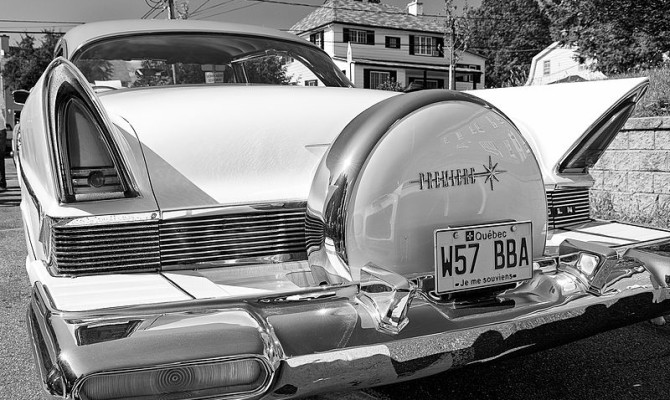
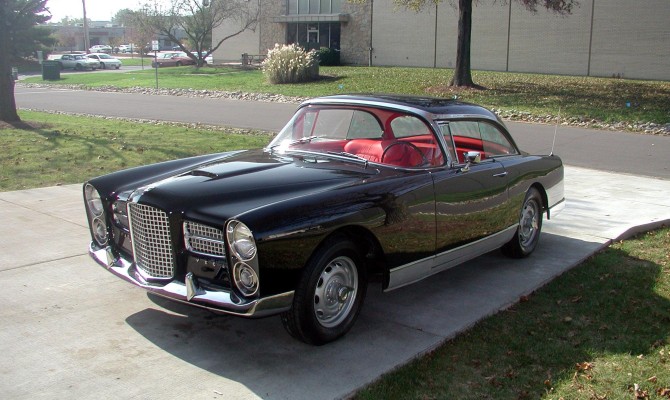
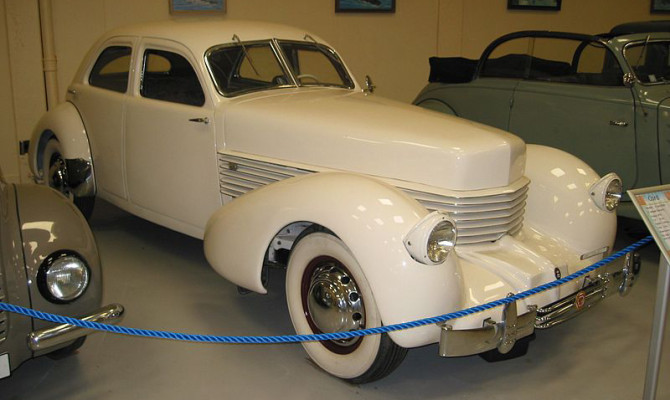
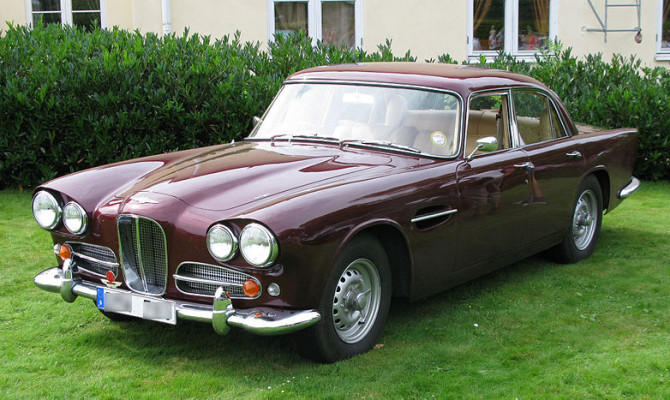
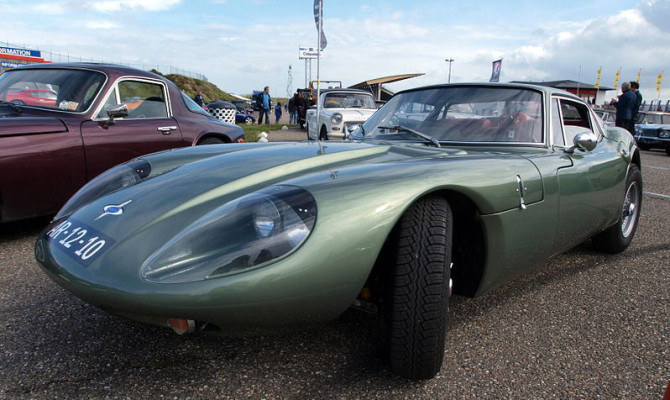
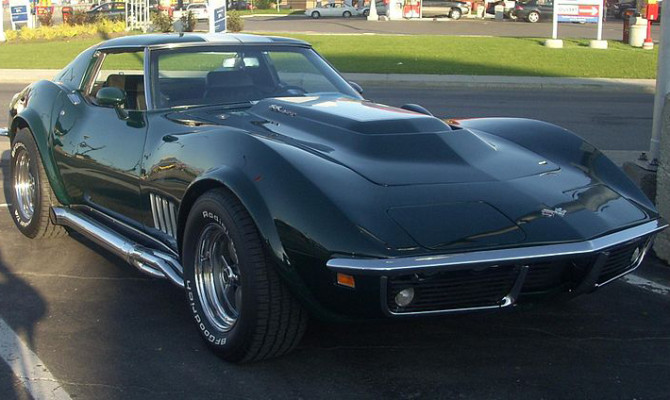
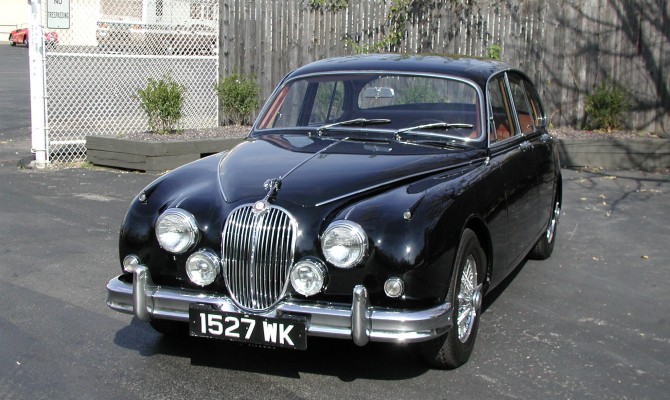
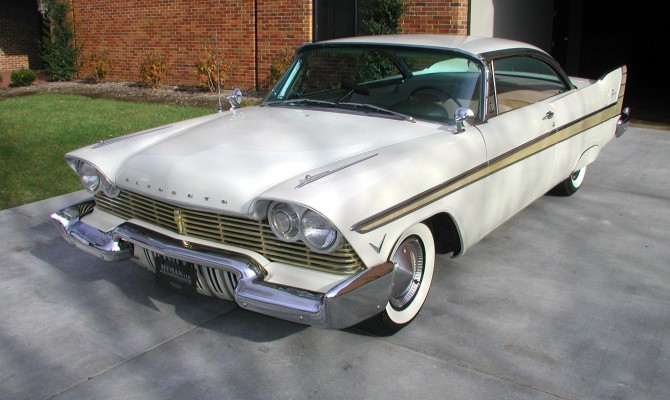
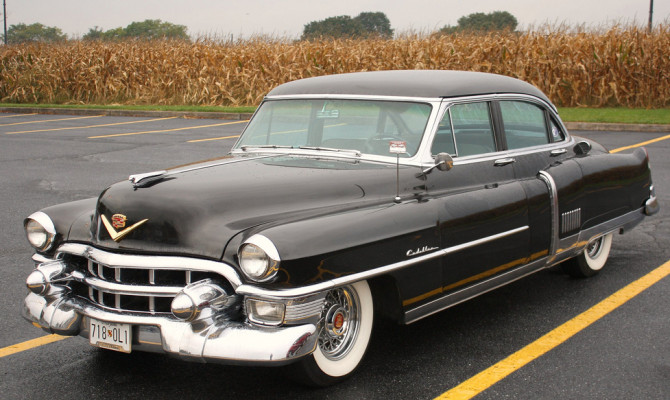
by Jonathan A. Stein
Like people, certain cars have a sinister look about them, especially in dark colours and particularly in black.
Some cars have been typecast for the large and small screens and others just look evil without any help from the mass media. Here are a handful of production cars that look as if they could scatter children and make law-abiding citizens run for their lives.
1935 Cord 810 Beverly or Westchester: Sleek and low for its era with that coffin nose, few cars have more of an air of threat about them. To me, the chrome pipes of the 812 take away a lot of the menace.
1957 Lincoln Premiere: Low, long, and wide, from its stacked headlamps to its perfectly proportioned fins, there is an air of menace about any ’57 Premiere in a dark colour.
I can’t see a ’52 or ’53 Cadillac Fleetwood in a dark colour without expecting Michael Corleone (Al Pacino) to step in or out of it. If ever a car was typecast, this is it.
1959-1966 Jaguar Mk II: This car has been cast repeatedly as the villain’s ride in all manner of British television and movies, though its menace is largely due to expectation rather than appearance.
1957 Plymouth Fury: This car would look threatening and scary even if it hadn’t been immortalized in Stephen King’s “Christine” as the embodiment of evil.
Very few cars look scarier than a Facel Vega HK 500 — in black. I’ll never forget the last time I saw a somewhat questionable – and now departed – car dealer. He was moving a black Facel Vega and it had a powerful burble and looked ready to spirit him away from a bank job or armored car heist.
1968-1972 Corvette Stingray: Talk about a car that looks “Bad Ass”; few cars top a black Stingray with chrome bumpers.
1961-1964 Lagonda Rapide: If there hadn’t been so few of them, this car definitely would have been a stereotypical “bad guy’s” car. They’re just plain menacing, even in white.
1963-1968 Marcos 1600 or 1800GT: Few cars are lower or look more sinister than these terrifically styled sports cars from England. They’re seldom seen on our shores. And although they look scary, they’d be hard to hop into for a quick getaway and there’s limited space to haul the loot.
The SAAB 900 Turbo had a very long life — from 1978 until 1998 — but it’s the cars from the mid-80s that will be best remembered as extremely predatory-looking. I’m talking about a black three-door Turbo, probably with tinted windows.
All kinds of cars make statements, but when you combine, long, low and wide with great presence, sometimes a car can be a little scary.
Jonathan A. Stein writes for Hagerty Insurance. Hagerty is the world’s leading specialist provider of classic car and boat insurance. Learn more at hagerty.ca
By Grant Stoecker
“American automotive manufacturers have made a number of performance cars exclusively for Europe and Australia, but have you ever heard of an African performance car?”
The U.S. and Canada might get a wide variety of unique and exotic cars, but there are a few cars that never made it to our showrooms and appear now only has special imports.
1972 Lancia Stratos HF
The Lancia Stratos HF is a monster of car. In the concept stages, the Stratos was an attempt by Bertone to get its foot in with Lancia, who had previously worked with Pinin Farina for design. The legend states that Bertone re-bodied a Lancia Fulvia and drove it to Lancia’s headquarters. Impressed with the Stratos prototype, Lancia agreed to collaborate with Bertone to create their next generation rally car. The Stratos was built around a Lancia chassis, with a Ferrari Dino engine positioned behind the seats. The rolling chassis was finished off with an aerodynamic body fitted by Bertone. The Lancia would go on to have a legendary career, winning the World Rally Championship from 1974-1976.
1973 Chevrolet Firenza Can Am
American automotive manufacturers have made a number of performance cars exclusively for Europe and Australia, but have you ever heard of an African performance car? Meet the Chevrolet Firenza Can Am, a Euro-American mash-up that was never sold in either of those markets. Built to compete with Ford’s inferior Capri Perana, the Can Am began its existence in Britain as a Vauxhall Firenza frame, which was then shipped straight south to Port Elizabeth, where it was paired with a power train straight out of an American legend — the 1969 Camaro Z/28. With a lightweight body and nearly 300 horsepower, the smell of burning rubber was a no-cost option, and I’m sure there was plenty of that. The car was limited to a run of 100, which were built to satisfy homologation requirements for Argus Production Car series, 30 of which are still known to exist.
1969 Ford Escort RS1600
While the latter part of the 1960s might have been the middle of the Mustang’s heyday, Ford was busy building fast cars all around the world. One of those cars was Ford’s venerable Escort, which was one of the top selling cars in Europe at the time. Of course, Ford engineers weren’t satisfied with a compact coupe with 1.3-litre engine, so they contacted the blokes over at Cosworth and developed the Escort RS1600. While the Cosworth engine may have put out only 113 horsepower, the tiny Escort was barely tipping the scales at 1,800 pounds, making the RS1600 one of the coolest cars cruising the UK at the time.
1969 Nissan Skyline GT-R
The Nissan Skyline GT-R is arguably the most iconic sports car to ever come from the islands of Japan. While the GT-R is most commonly idolized in its mid-’90s guise from the Fast & Furious franchise, our pick is the original — the 1969 Skyline GT-R. Introduced at the 1969 Tokyo Auto Show, the GT-R was a Nissan Skyline sedan that was stripped out and given the special treatment by the boys in the Nissan Skunks Works team. The heart of the GT-R is a Nissan racing V-6 engine putting out 160 horsepower, allowing the GT-R to outrun its European rivals. Other cool upgrades included wide wheel arches, rally wheels, front and rear spoilers, and of course, the now-iconic GT-R badges.
The Porsche 959 is a perfect example of what happens when some German mad scientists in Porsche decide that the 911 Turbo isn’t just quite enough. Built to be the ultimate Group B rally car, Porsche decided to slap an all-wheel drive system and a twin-turbo 2.8-liter boxer engine in a highly modified 911. In order to fulfill the FIA’s homologation rule, Porsche built 337 examples for consumption by the public. Of course, the EPA and Porsche weren’t quite on the same page, and the 959 was never legally sold in the U.S. However, several example of the 959 have made their ways to our shores, most notably the “Gates 959,” which was stored by U.S. Customs for 13 years and was key in the passing of the “Show and Display” law.
Grant Stoecker writes for Hagerty Insurance. Hagerty is the world’s leading specialist provider of classic car and boat insurance. Learn more at hagerty.ca
“With four distinct trim levels, the Chrysler 200 can match the wherewithal of many pocketbooks while employing the latest in safety and technology to deliver an affordable upscale driving experience…”
by Rob Rothwell
Driveway Canada
You can pay a fortune for a premium brand but you needn’t break the bank to buy wheels with style.
Chrysler 200 (starting MSRP $19,945)
Chrysler stunned the marketplace with the introduction of its completely new 200 Sedan, resetting benchmarks for style, panache, and performance within a fiercely competitive segment. And with a starting MSRP of just $19,945, the 200 undercuts many of its competitors, yet its real strength is found in its range of trim levels and power options. The base engine is a 2.4L four-cylinder affair that feeds 184 horsepower to the front wheels through a segment-exclusive nine-speed automatic transmission. Going upscale in the 200 brings with it Chrysler’s powerful 295 horsepower Pentastar 3.6L V6 engine paired with the nine-speed autobox and all-wheel-drive traction. Standard features include eight airbags, Keyless Enter ‘n Go, and Chrysler’s Uconnect 3.0 multimedia centre. Options include Blind Spot Monitoring, Adaptive Cruise Control with Stop and Go, Forward Collision Warning with Active Braking, and Active Park Assist. With four distinct trim levels, the Chrysler 200 can match the wherewithal of many pocketbooks while employing the latest in safety and technology to deliver an affordable upscale driving experience.
Fuel Economy:
2.4L I-4 10.2L/6.4L100km city/highway
3.6L V6 12.4L/7.5L100km city/highway
Acura TLX (base MSRP $34,900)
The four-door Acura TLX Sedan replaces the former TSX and TL sport sedans, merging their respective strengths into a single product positioned as the brand’s mid-level contender. With a base sticker of $34,900, the TLX delivers plenty of sport-inspired luxury built around a 206 horsepower 2.4L four-cylinder power plant fused to an eight-speed automatic transmission. Propulsion is directed frontward unless the V6 Technology Package and Acura’s Super-Handling All-Wheel-Drive system with torque vectoring are opted for. In which case, all four wheels share in 290 horsepower produced by the 3.5L SOHC i-VTEC mill. A sophisticated nine-speed automatic transmission further contributes to the engaging performance of the V6-powered TLX. In addition to a more rigid body structure, the TLX provides increased safety and collision avoidance with the use of technology such as Jewel Eye LED headlights, Lane Departure Warning, Forward Collision Warning, and Blind Spot Information with Cross Traffic Warning. Comfort and convenience essentials include the availability of premium 10-speaker audio along with voice-activated navigation.
Fuel Economy:
2.4L I-4 9.6L/6.6L/100km city/highway
3.5L V6 11.2L/6.9L/100km city/highway
Audi A3 (base MSRP $31,100)
Looking remarkably like the highly successful Audi A4 Sedan despite casting a shadow 245mm shorter, the new A3 Sedan is sure to capture the attention of entry-level Audi buyers that scorn the A3’s hatchback design despite the vehicle’s praiseworthy driving dynamics and general practicality. Pricing for the new A3 Sedan starts at $31,100 with the 170 horsepower 1.8L TFSI I-4 power plant turning the front wheels through the auspices of Audi’s six-speed S tronic automatic gearbox. Upping the ante to $35,900 secures a 220 horsepower 2.0L TFSI I-4 connected to all four corners via Audi’s quattro all-wheel-drive technology. Diesel power is also available in the A3 Sedan, though paired only with front-wheel-drive. Option combinations include Audi’s Styling Package, Navigation Package, and their sport-oriented S line Package. Audi has always been a technology leader, and the A3 Sedan shares in that reputation with a vast array of onboard safety and protection systems.
Fuel Economy: TBD
Mercedes-Benz C 300 Sedan – C400 Sedan (base MSRP C 300 $43,000 – C400 $51,400)
Despite slotting beneath the venerable E-Class in the Mercedes-Benz hierarchy of sedans, the new C-Class Sedan takes on a notably formal appearance and a more upscale demeanor for 2015. It’s also lighter and more powerful thanks to the extensive use of aluminum and a pair of revised engines. The C 300 receives a turbocharged 2.0L I-4 power plant capable of 241 horsepower. Need more oomph? A 3.0L twin-turbo V6 places 329 horsepower under the hood of the C 400. Both engines feed all four wheels through Mercedes-Benz’s 4MATIC all-wheel-drive technology. The sole use of 4MATIC is a Canadian-market exclusive. Along with new sheet metal and a lavishly-appointed cabin, the C-Class is equipped with the latest generation of COMMAND by Mercedes-Benz. This highly sophisticated infotainment/navigation system is lifted directly from the S-Class flagship. Audiophiles will appreciate the availability of Burmester surround-sound audio components, which are hand-made in Germany.
Fuel Economy:
C 300 10.9L/7.5L/100km city/highway
C 400 11.1L/8.4L/100km city/highway
BMW 228i – M235i (base MSRP 228i $36,000 – M235i $48,750)
Reminiscent of the legendary 1968 BMW 2002 Coupe, today’s 228i and M235i Coupes combine the outstanding driving dynamics of the stubby BMW 1-Series Coupe, which they replace, with a sleeker, more aggressive interpretation of the iconic brand’s ethos. The 228i is the tamer of the pair, but with 241 horsepower and 258 lb.-ft. of torque, its 2.0L twin-turbocharged I-4 engine delivers highly spirited performance nonetheless. If outright exhilaration is the target, the M235i is the ticket. Its twin-turbocharged 3.0L I-6 mill produces 322 horsepower and 332 lb.-ft. of endless torque. For true driver-oriented motoring, both vehicles can be fitted with a 6-speed manual gearbox in place of the new 8-speed automatic transmission. BMW’s xDrive all-wheel-drive traction is also available, but can only be paired with the automatic transmission. With the availability of a manual gearbox backed by a choice of turbocharged power plants, the new BMW 2-Series may just be the “ultimate driving machine.”
Fuel Economy:
228i 9.1L/5.6L/100km city/highway
M235i 11.2L/7.1L/100km city/highway
 As kids we were always told to dress for the weather, so how about adding the state of darkness/daylight to that piece of wisdom?
As kids we were always told to dress for the weather, so how about adding the state of darkness/daylight to that piece of wisdom?
I can’t believe the number of darkly-dressed pedestrians who jump out from the curb in the pouring rain on these fall nights when it gets dark so early. (more…)
“My biggest fear is that someone I love will be in a horrific, life-changing, potentially fatal car accident.”
by Lauren Kramer
**********
My kids have my permission to yell at their dad whenever they spot him using his cell phone while driving.
Which, unfortunately, is often. I’ve coached them on what to say: “You’re putting my safety at risk,” “You’re breaking the law,” and “Dad, put your phone away this minute!”
I’m not alone when I say my biggest fear is that someone I love will be in a horrific, life-changing, potentially fatal car accident. And every time a driver picks up their phone while operating a car, that accident becomes increasingly likely.
We’re all doing it, but we know we shouldn’t.
Sneaking peeks at our cell phones while we’re driving has become an irresistible temptation as more and more of us become addicted to checking email, responding to texts and answering calls whenever they come in – and no matter what is going on around us.
It’s easy to rationalize. “This will just take a second,” we think, exaggerating the amount of time it takes to, say, respond to a text message. According to the Canadian Automobile Association the average distraction time for this task is 22.6 seconds, the distance of 373 metres of travel at 40 km/h and the equivalent of four intersections or 68 parked cars.
But it’s not just the texting time that’s so perilous, it’s the time it will take you to regain your focus on the road, to bring your car to a standstill if you have to. Perception, reaction and braking time after a distraction like this – even something as minor as hitting two letters to type “OK” – is 25 metres, the equivalent of a lineup of 17 people.
That’s a long time when you’re controlling a powerful, hunk of metal like a car.
The truth is that cell phones have become every much as dangerous an addiction when driving as inebriation – even more so because they lack the ugly stigma associated with drunk driving. Yet the probability of being in a crash while you are distracted is horrifying. Texting, even just a word? You are 23 times more likely to crash. Talking on your cell phone – four-to-five times more likely. And reading that ‘urgent’ email that simply couldn’t wait makes you three times more likely to be in a potentially fatal accident, according to research by CAA.
Findings by ICBC show that distracted driving is the second leading contributing factor of vehicle fatalities in BC. That’s why, October 20, new penalties for distracted drivers were implemented in this province. If you are caught with your cell phone in hand or programming your GPS while driving, you’ll get a $167 fine and a deduction of three penalty points. It’s a rap on the knuckles but also a reminder to fight our addiction to electronic devices while we’re driving.
Because the fact is, for even the best drivers, it’s impossible to safely split your attention while you’re driving. Don’t be fooled if you’ve been lucky thus far, because driving while distracted and not crashing or causing an accident has more to do with luck than competence. And seriously, why wait for luck to run out?
Overcoming that cell phone addiction on the road is as easy as turning off your phone and putting it in the glove box or trunk of your car, where you absolutely cannot reach it while you are driving. That’s what instructors at Mercedes Benz Driving Academy insist their students do when they step into a car. Yes, I know, you are expecting an important call so you don’t want your phone off. In that case, Bluetooth or wired headsets (worn only in one ear unless you are on a motorbike) are the next best thing.
But the key is to make sure your phone is out of reach, because when it is within stretching distance, it’s a pinging candy bar most of us can’t refuse.
Contact: laurenkramer [at] shaw [dot] ca
“While the day was filled with fun and excitement, it also served a greater purpose by developing driving skills that are completely transferrable to the street.”
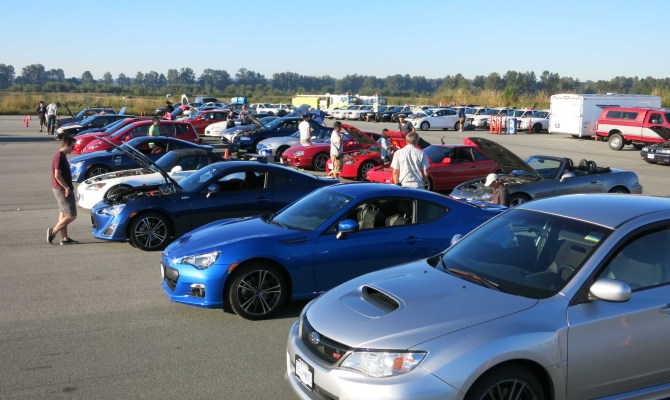
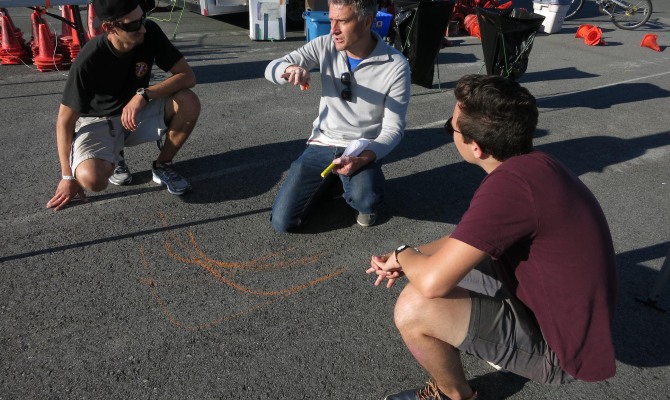
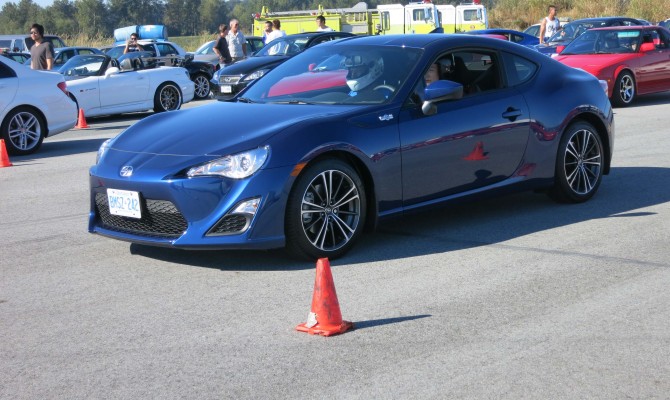
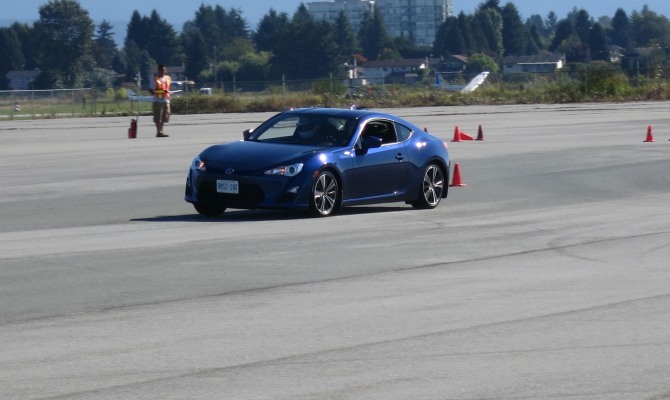
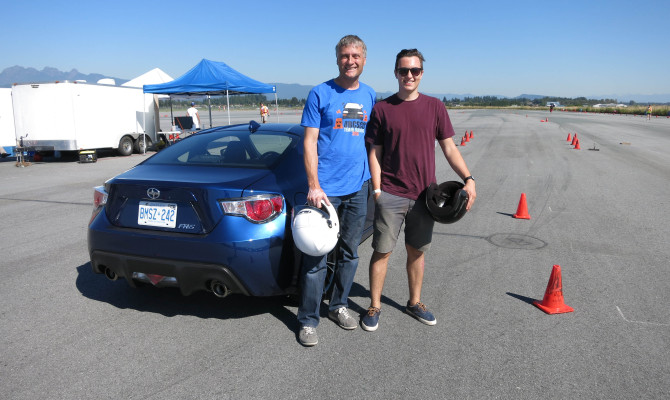
by Rob Rothwell, Driveway Canada
**********
Octane-fuelled learning crosses age and gender boundaries
With comments such as “amazingly passionate” and “best prof ever” peppered throughout the reviews on Rate my Professor, UBC’s physics/engineering Prof Dr. Andre Marziali clearly scores top marks from his students. However, his rave reviews extend beyond the walls of academia to the pavement of the Pacific Traffic Education Centre (PTEC), abutting the Pitt Meadows Airport. (more…)
“Total strangers often boldly approach us in the veggies’ section to ask what car they should buy next.”
**********
Judging by the number of people who stop to chat to members of the Driveway team in the supermarket, most of you still rely on newspapers like this one to help narrow down your next-car shortlist.
Total strangers often boldly approach us in the veggies’ section to ask what car they should buy next. After a few questions about what their budget is and how they will use the vehicle, we can usually give them five products to consider. I should add, that lead reviewer Zack Spencer fields most questions in airport lounges across the country!
Next to house buying, it’s generally a family’s second largest purchase made, so it should be no surprise that people want to seek advice. (more…)
Recent Comments
- { Enjoyed your Forest of Bowland in the BMW X5M, particularly the photo of the BMW in front of the main part of Stonyhurst College where... }
- { Bantam designed the Jeep, not Willy's or Ford. The American military gave the original Bantam prototype to Willys and Ford to copy. There is plenty... }
- { All Escalades come with a 6.2-lilter V8 engine that produces 420 horsepower. A six-speed automatic is the only transmission offered and drives the rear wheels.... }
- { Alexandra is an excellent journalist. }
Popular Posts
- Journey to a ‘Sparkling’ Luxury Okanagan Resort “Four lucky readers will put a Dodge Journey’s weekend-...
- The Need For Speed: Hike Those Highway Limits More than half of those polled believe the province sho...
- Drives-U-Crazy… Erratic drivers. An early morning drive from Kelowna to Vancouver is nor...
- Readers Respond: The Pros and Cons of Increasing B.C. Speed Limits Increasing the speed limits will only increase risk to...
- Honda CR-V Review: The Compact Crossover To Get Things Done The CRV is a very stylish and aerodynamic crossover veh...


